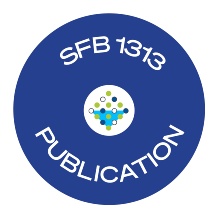New SFB 1313 publication, published in International Journal of Multiphase Flow. The work has been developed within the SFB 1313 research project A02.
Authors
- Sina Ackermann (University of Stuttgart, SFB 1313 associated member)
- Stephanie Fest-Santini (University of Bergamo, SFB 1313 external partner, research project A02)
- Maiar Veyskarami (University of Stuttgart)
- Rainer Helmig (University of Stuttgart, SFB 1313 research project A02)
- Maurizio Santini (University of Bergamo, SFB 1313 external partner, research project A02)
Abstract
Droplets formed on the hydrophobic surface of a porous medium exposed to a cross-flowing gas stream have a strong influence on the mass, momentum, and energy exchange across the porous interface, being of importance in several physical systems and engineering applications, like fuel cells. However, the fluid displacement front is highly complex at the pore-scale, since it is characterized by the surface wettability and a contact angle variation along the triple line. Furthermore, the droplet formation is affected by the pore geometry and the surface wettability. These result in a challenging multi-phase scenario with controversial literature, and few studies consider the detailed mechanism of droplet formation on the surface of the porous medium. In this work, two multi-scale simulations for the emerging water droplet from a single hydrophobic capillary pore opening into the gas phase are validated by a benchmark experiment with the help of a high-resolution X-ray imaging technique to characterize the droplet growing. A three-domain approach (gaseous free flow, interface and porous medium, FIP) was compared with a two-domain approach (based on a free-flow and the porous medium, FP). Whereas the three-domain approach introduces two sets of coupling conditions, one for the free flow-interface and one for the interface-porous medium, the two-domain approach introduces only one set of coupling connections for describing the interaction between the domains. In both approaches, droplet formation and growth alter the coupling conditions between the domains. While the FIP approach treats the porous medium as a continuous matter, it is resolved discretely with the help of a pore network in the FP approach. Both approaches show good agreements with the experimental observations and high correspondences for the drop volume, radii and contact angle evolution. The proposed models provide a base for future developments and help to gain a better insight about the impact of the droplet formation on the interface in a coupled free flow-porous medium system.

Sina Ackermann
Dr.-Ing.Postdoctoral Researcher
Stephanie Fest-Santini
Dr.External Partner, Research Project A02

Rainer Helmig
Prof. Dr.-Ing. Dr.-Ing. h.c.Principal Investigator, Former Spokesperson, Research Projects A02 and C02, Central Project Z


